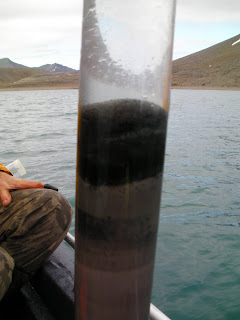Okay, so the core I retrieved today may not be considered gold to most of you, but when you drop a plastic device down to the bottom of a 150-foot deep lake, pull it up and retrieve a beautiful core of mud, successfully cap it and transport it back to the shore, you feel like you've struck it rich. That was exactly what went down today, twice! Although I owe the credit to the first successful core to Professor Mike Rotelle of Bates College who successfully cored and pulled up the first piece of mud. Of course, the day would not have been half the success it was without Al Werner, professor from Mount Holyoke, and two of my peers, Alex and Alice, that helped with the coring and water sampling process, and most importantly of all, carrying all the gear tools and equipment up to the lake which is an additional hour hike each way from the south hut on Lake Linne (Linnevatnet). Below is a picture taken by Mike of Al, Alex and I returning with the core of mud.

It's tough getting pictures from everyone but as I get some good shots I will keep them coming.

Here is a nice shot of us enjoying our lunches with Kongressvatnet (the lake I cored and will be analyzing for my senior thesis) in the background. It is still hard for me to believe that a lake that is maybe 1/3 mile wide is 150 feet deep!
Anyways, this morning started out extremely foggy. We couldn't see more than 100 yards ahead. Just as we got to Linne, the sun broke through and it got warm! I'm talking over 50 degrees warm. It was a perfect day for the longer hike up to Kongress where all of my success occured. Unfortunately, the fog rolled back in this afternoon and they are predicting rain for the next two or three days.
Before I leave for bed I'll share with you a little scientific information about the lake I am studying, Kongressvatnet. What makes it so unique over Linne (which is much easier to access, larger, and coreable) is that it is meriomictic. That means that layers don't intermix, that is, it is a stratified lake. Normally, lakes mix and overturn twice a year (especially in temperate climates such as New England), but towards the bottom of Kongress, it goes completely anoxic. Chemical reactions taking place at the bottom of this lake (about the deepest 30 feet) create a reducing state which basically prevents any oxygen from surviving. This water is sulfur rich, and being just a slight bit denser than the rest of the lake, it prevents it from mixing with upper, lighter layers. And when you pull up a sample of its water, it smells like rotten eggs (the smell you get some sulfates). The location in the water where this takes place is known as the "chemocline".
This of course brings us to the most important part about this lake being meriomictic! Since it is depleted of oxygen at the bottom of the lake, very few organisms can actually survive down there (there are these little things known as purple sulfur bacteria but they don't really pose a threat to my work). So, since you don't have little clams or fish digging through the top layers, these sediment deposits go untouched. This is what gets you those fine annually laminated varves that I spoke of in my first post! So I think I have bored you (or perhaps entertained you) with enough science for today. Do a search of meriomictic or chemocline, or even lake varves if you want to learn more.
Also... the place that we are staying at has a website, and hosts tour groups as well as vacationers making their way here on their own. If you want to check out the accommodations (they also have some great pictures of the area)
click here. Goodnight!
 A view of the tarmac at the airport after arriving, time 12:15 AM
A view of the tarmac at the airport after arriving, time 12:15 AM
















